If you recently bought an expensive 5G-ready smartphone but live near an airport, you may be out of luck.
To the surprise of the telecommunications industry, the federal government recently announced plans for new 5G service restrictions near most major airports that could deprive thousands of a true 5G experience.
Canada’s telecoms companies spent $ 9 billion acquiring 5G spectrum licenses in July, and Telus Corp. says the restrictions, which were announced just two weeks after the auction concluded, could reduce the value of their $ 1 purchase. 2 billion at $ 100 million.
“Telus was very surprised to learn, just a week after making a multi-million dollar pledge, that the proposed technical changes would affect a significant amount of the spectrum it won at auction,” the company said in a Sept. 2 comment filed with the Department of Innovation, Science and Economic Development (ISED).
In a separate presentation, Telus said that “and the mobile phone industry as a whole” were “baffled” by the policy implications.
The government said it is introducing the restrictions because there are concerns about possible interference between those radio waves, which are known as spectrum and carry wireless communications signals, and certain aviation navigation tools.
ISED, which also held the spectrum auction, said on August 6 that it would conduct a brief consultation and then establish new restrictions that will apply to airports where automatic landing is allowed.
But Telus says the restrictions are more drastic than the precautions taken in other countries.
In the case of Toronto Pearson International Airport, the restrictions will cover a wide area surrounding the runways themselves, where 5G base stations will not be allowed, plus two long stretches from Etobicoke to Brampton and another two from Downsview to Mississauga. On longer stretches, there will be limits on power use, which can affect network performance.
ISED said the restrictions are necessary because there is a possibility that radio signals from 5G equipment on the new spectrum frequency could interfere with the operation of altimeters, which are used in automatic flight guidance systems.
5G technology is expected to deliver faster download speeds and transport more data, as well as connect a wide range of devices, from self-driving cars to smart city sensors.
Telus said the restrictions will affect cell phone users who live near airports and want to get 5G service and will impede the development of new technologies in warehouses, manufacturing plants and hotels that often surround airports.
“(The proposed restrictions) will hamper the ability of wireless carriers to deliver on the promise of 5G connectivity to these industries,” Telus said.
Canada’s big three wireless companies, Telus, BCE Inc. and Rogers Communications Inc., began rolling out the first versions of 5G service in some cities last year.
But 5G technology will use a combination of different frequencies and the airwaves purchased in the recent auction, which are in the 3,500 megahertz frequency range, are seen as crucial to improving service and extending coverage.
Many leading wireless companies around the world have used this type of spectrum for 5G service, and equipment manufacturers make network equipment designed for it.
Aircraft radio altimeters operate in the near 4,200 to 4,400 MHz frequency band.
In an emailed statement, ISED spokesman Sean Benmor told the Star that spectrum regulators around the world have been evaluating studies showing “potential interference from 5G flex-use operations in the 3500 MHz band.” .
“Some countries, such as France and Japan, have already implemented mitigation measures while others are studying the issue,” Benmor said. He added that ISED published a bulletin in March, several months before the spectrum auction, pledging to study the issue and warning that rules could be developed for the operation of 5G in the new spectrum band.
Telus maintains he was unprepared for the limits the government has now proposed and said other countries have decided on smaller “guard zones” between the frequency where altimeters operate and the frequency where 5G services are allowed.
He said that US regulators determined that a 220 MHz guard band “would be sufficient to protect the needs of the aviation industry,” while Canada proposes a buffer between 550 MHz and 700 MHz.
Telus said the watch zones in Australia and Japan are 200 MHz and 100 MHz, respectively.
Telus did not comment beyond his formal comments on the consultation and Bell and Rogers declined to comment before the October 15 deadline to submit additional submissions to ISED. The government initially requested comments before August 23, but delayed that date after receiving several requests for more time.
“The measures may affect implementation plans for outdoor 5G operation in the 3,500 MHz band around some airports, but locations outside airport zones should not be significantly affected,” said ISED’s Benmor. “Indoor deployments near those runways would not be affected either.”
He added that the government will continue to study the issue and could modify or relax the measures “within the 20-year term of ISED’s 3,500 MHz licenses.”
Use this interactive map to see if you live near one of the airports where 5G service will be restricted (select “Both zones” from the drop-down menu): https://www.ic.gc.ca/eic/site/smt-gst.nsf/eng/sf11726.html
Reference-www.thestar.com
